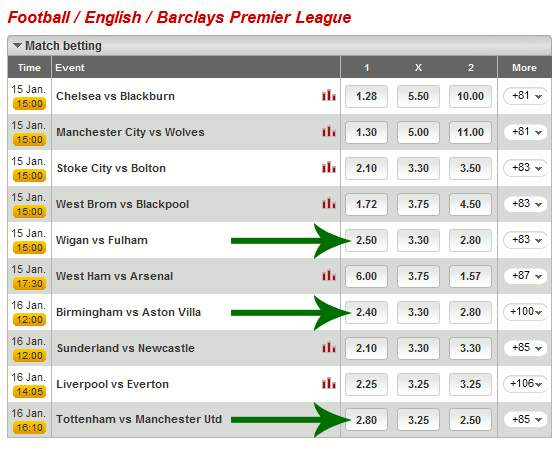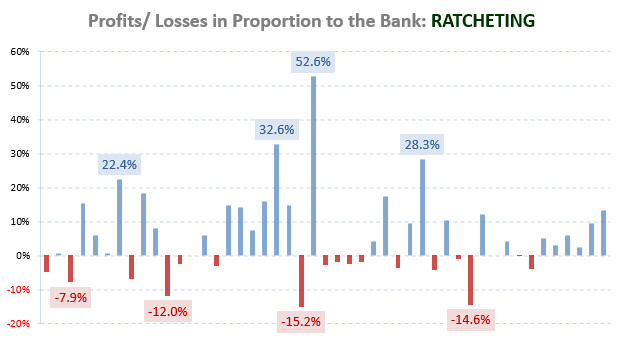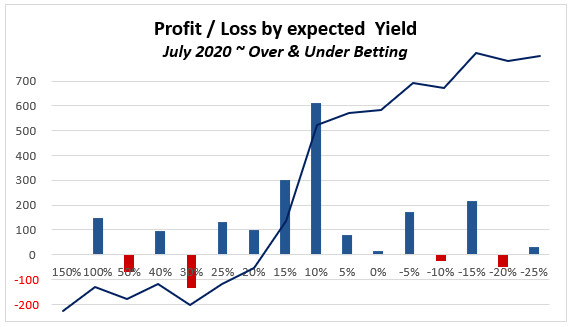
Also known as “System X1“, this scheme is lauded in many circles as very profitable. A quick search on the Net will reveal many articles with authors assuring their readers that they use System X1 themselves.
It is based on the half-time/full-time betting market where there are nine possible combinations: home/home; home/draw; home/away; draw/home; draw/draw; draw/away; away/home; away/draw; away/away.
 Image: Dusit (Shutterstock)
Image: Dusit (Shutterstock)System X1 Rules:
- Look through the fixture lists and bookmakers odds to identify games where the teams are fairly evenly matched; where both are priced somewhere between 2.3 and 2.75 (fractional prices from 13/10 to 7/4).
- You need to find at least five of these fixtures. Indeed, the total number of games you decide to back has to be divisible by five (I will explain later why you will need five, 10, 15 or more of these fixtures to make the system work).
- Because evenly matched teams have been selected the main assumption of the system is that the result at half-time will hopefully be a draw (X).
- However, the required full-time result is probably the most common in every league in the world: the home win (1). Hence the name System X1.
System X1 Maths:
Approximately 45% of all English league fixtures involving evenly matched teams end in a home victory. Also, with equally strong teams the chances are pretty good that the game will be drawn at half time. Usually, the odds for the draw in the half-time result market is the smallest price.
This system is based on nothing more than simple statistics and the law of large numbers. In other words, a portfolio of bets of the same kind.
For the draw/home HT/FT combination bet, bookmaker odds are usually somewhere between 5.0 and 7.0 (fractional odds from 4/1 to 6/1).
Naturally not all fixtures will finish with the draw/home HT/FT combination and odds of this size therefore allow for losses to be absorbed and hopefully a profit to be made. From five bets at this level of odds only a single selection needs to be correct for profits to accrue (i.e. 20% of all placed bets).
System X1 In Practice:
I will investigate this system using a selection of fixtures courtesy of Ladbrokes. Not only are they one of of the largest and historically most consistent bookmakers in the UK, they also publish well-arranged, easy-on-the-eye fixture lists.
For this experiment I have identified 14 English fixtures fitting the System X1 criteria (which I will eventually whittle down to 10):







Hi there,
I would like to know if you can provide half time and full time service football tips with 20-70 odds?
Kind regards,
Hi Nelson,
I’m very sorry but we no longer provide tips on the Soccerwidow site.
Instead, we encourage and teach people to adopt a ‘Do It Yourself’ approach.
It is always much better to be in total control of your bank knowing how and why you are making betting selections, and what the long-term outlook is.
Following an anonymous tipping site entails a great deal of blind faith. It’s not something we would recommend.
This is very interesting indeed! I just want to ask you how to you calculate the stakes using the formula , because im not finding the value that its presented
Formula for Weighting:
∑ Odds / Odds = Ratio (Weighting)
Formula for Calculating the Stakes:
Total Bank for betting on this event / ∑ Ratios (Weighting) x Odds = Stake
Calculating price difference?
What do you mean? Please can you rephrase your question?
Can you show me how did you calculate the stakes distibution using this formula:
Total Bank for betting on this event / ∑ Ratios (Weighting)
x Odds = Stake
Hi Marco, I’m going to address your question (and others) within a series of articles about maths. You are not the only one who asks. These questions pop up all the time, other people even asking what a ∑-Symbol means.
Unfortunately, I cannot promise how quick, but it’s on my current to-do-list. 🙂
Thanx its a great idea ..will try it out
Interesting stuff.i wasn’t aware of this,I must say.On another thread I mention a friend who is very successful betting on overs .He also manages to profit from betting on HT-FT markets at the very high 1 2 or 2 1 prices.
I hate him.